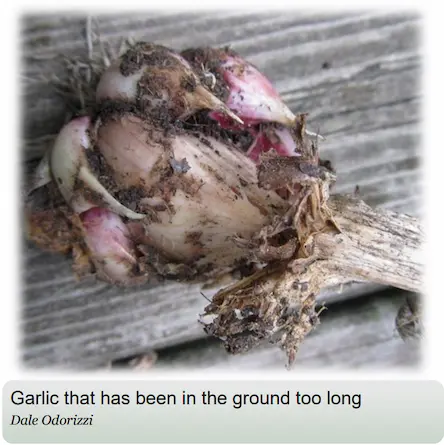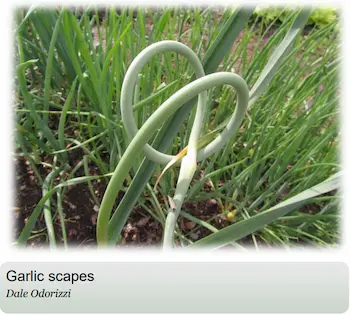Your cart is currently empty!
When is My Garlic Ready to harvest?
Photo:
Photo by Shelley Pauls on Unsplash
Author: Dale Odorizzi, Master Gardeners of Lanark County; published with permission
Garlic is a wonderful crop. You plant it in October, mulching it well to help the soil stay warm enough for roots to form and to keep it cozy all winter.

In the Spring
In early spring, you pull the mulch back a bit to watch the garlic sprout, but leave the mulch in the bed to help suppress weeds and keep the soil moist. That is about all it takes to grow great garlic. The big question is: “When can I harvest it?” Garlic has three opportunities for harvest.
First, when the shoots appear, you can use garlic much like you do green onions. When the leaves are 10–15 cm high, you can pick them and add them to salads or stir-fries. Remember, if you pick a clove and use the leaves, you end the growth of that clove. The only time I do this is if I have missed harvesting a bulb or two the previous fall.
Don’t Permit Overcrowding
You can tell which bulbs were missed by the four to six new plants growing, all clumped together. These plants will not develop properly as they are too crowded. Sometimes, I have dug up these missed bulbs, separated them, and replanted them. This is not always successful, but one hates to waste garlic!
The Second Harvest and Garlic Scapes
The second harvest takes place when your garlic plants start to develop a curl on top (see photo). These curls are known as garlic scapes and only occur on hard-necked garlic. The scape should be cut off near where it comes out of the leaves.

The scapes are great in stir-fries and make a wonderful pesto sauce. If the garlic scapes are left to grow, they will become the garlic flowers, and bulbils will form from the flowers. These bulbils are clones of the mother plant and can be planted like garlic cloves. However, it will take two to three years for these bulbils to produce full garlic cloves.
Even if you do not plan to eat the scapes, you should remove them from the plant unless you are planning to plant the bulbils. The development of flowers and bulbils takes energy from the mother plant, and the cloves will not be as large as those that have had the scapes removed.
The Final Harvest
The final garlic harvest, and the one you have been waiting for since that cold day in October when you planted your cloves, occurs sometime between the first week in July and the middle of August, depending on the variety. If you lift the bulbs too early, they will be undersized and not store well. If you lift them too late, they will lack the protective paper-like wrapping around the bulbs.
So how do you know when it is just right? Watch the leaves. The green leaves start to die from the bottom up. When the bottom three to four leaves are dead and the top five or six are green, it is time to lift the bulbs. If you are not sure, dig up a bulb or two and check. A mature bulb is fully swollen, well-sized, and has some partially decomposed wrappers.
Handle with Care
Garlic is very fragile and should not be bumped, bounced, or dropped, as even the smallest bump will bruise it, causing early decay and loss of quality.
Pick a dry day for harvesting. Carefully lift the bulbs with a garden fork and take them, green leaves and all, for cleaning and curing. Don’t leave garlic in the hot sun, but move it quickly to a shady spot to avoid ‘cooking’. If your soil is sandy loam, any dirt can be gently brushed off. Clay soils tend to adhere to the bulbs and may need to be washed off with a gentle spray of fresh water. Trim roots to one centimetre and carefully remove any dirt from the roots.
Curing and Storing Garlic
Garlic needs about two weeks to cure to prepare it for winter storage. To cure garlic, either hang it in bundles of 10–12 or place it on mesh racks in an airy, ventilated drying area. Ensure good airflow and protection from direct sunlight, rain, or other moisture. Once your garlic is cured, trim it to remove the stalks. When trimming your garlic, if you notice any that have been damaged in the harvesting and curing process, store them separately and use them first. If your cloves have started to separate, use them as soon as possible or in October for planting because they do not store as well as a nice, compact head of garlic.
Garlic bulbs are best stored at room temperature (18 to 20°C) and in low humidity. Never store garlic in the refrigerator, as too-low temperatures will cause premature growth. Different strains and varieties of garlic have different storage lives, varying from six months for ‘pickling’ garlic up to 11 or 12 months for some soft-neck strains.
The beauty of garlic is that, if you are careful, you only need to buy it once. You can use garlic from this year’s harvest to start next year’s crop.
About the Author
Share with Family and Friends
Featured Authors
Visit a Botanical Garden For Unique Experiences.
Comments
Logging in to comment gives you more features, but it is not required.
Subscribe
0 Comments
Oldest












